Prudential Financial, Inc. 5.62 (PRS) 8-KRegulation FD Disclosure
Filed: 4 Nov 10, 12:00am
 November 4, 2010 Prudential Financial, Inc. Prudential Financial, Inc. 1 Exhibit 99.1 |
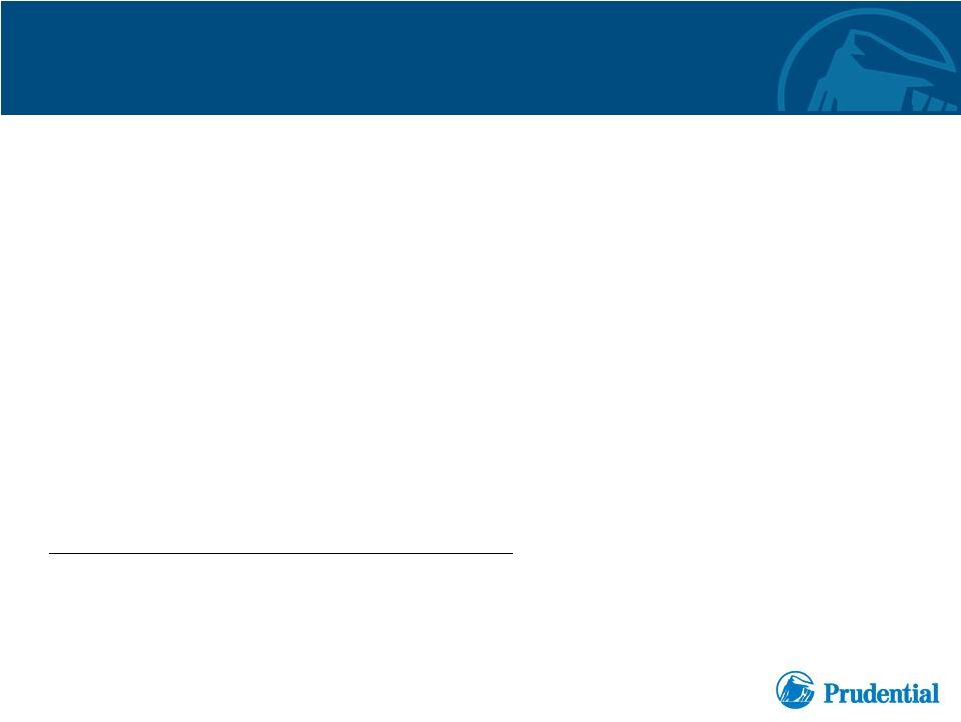 Forward-Looking Statements; Risk Factors 2 Certain of the statements included in this presentation constitute forward-looking statements within the meaning of the U.S. Private Securities Litigation Reform Act of 1995. Words such as “expects,” “believes,” “anticipates,” “includes,” “plans,” “outlook,” “assumptions,” “guidance,” “estimates,” “projects,” “considerations,” “potential,” “intends,” “should,” “will,” “shall” or variations of such words are generally part of forward-looking statements. Forward-looking statements are made based on management’s current expectations and beliefs concerning future developments and their potential effects upon Prudential Financial, Inc. and its subsidiaries. There can be no assurance that future developments affecting Prudential Financial, Inc. and its subsidiaries will be those anticipated by management. These forward-looking statements are not a guarantee of future performance and involve risks and uncertainties, and there are certain important factors that could cause actual results to differ, possibly materially, from expectations, estimates or projections reflected in such forward-looking statements, including, among others: (1) general economic, market and political conditions, including the performance and fluctuations of fixed income, equity, real estate and other financial markets; (2) the availability and cost of additional debt or equity capital or external financing for our operations; (3) interest rate fluctuations or prolonged periods of low interest rates; (4) the degree to which we choose not to hedge risks, or the potential ineffectiveness or insufficiency of hedging or risk management strategies we do implement, with regard to variable annuity or other product guarantees; (5) any inability to access our credit facilities; (6) reestimates of our reserves for future policy benefits and claims; (7) differences between actual experience regarding mortality, morbidity, persistency, surrender experience, interest rates or market returns and the assumptions we use in pricing our products, establishing liabilities and reserves or for other purposes; (8) changes in our assumptions related to deferred policy acquisition costs, valuation of business acquired or goodwill; (9) changes in assumptions for retirement expense; (10) changes in our financial strength or credit ratings; (11) statutory reserve requirements associated with term and universal life insurance policies under Regulation XXX and Guideline AXXX; (12) investment losses, defaults and counterparty non- performance; (13) competition in our product lines and for personnel; (14) difficulties in marketing and distributing products through current or future distribution channels; (15) changes in tax law; (16) economic, political, currency and other risks relating to our international operations; (17) fluctuations in foreign currency exchange rates and foreign securities markets; (18) regulatory or legislative changes, including the recently enacted Dodd-Frank Wall Street Reform and Consumer Protection Act; (19) inability to protect our intellectual property rights or claims of infringement of the intellectual property rights of others; (20) adverse determinations in litigation or regulatory matters and our exposure to contingent liabilities, including in connection with our divestiture or winding down of businesses; (21) domestic or international military actions, natural or man-made disasters including terrorist activities or pandemic disease, or other events resulting in catastrophic loss of life; (22) ineffectiveness of risk management policies and procedures in identifying, monitoring and managing risks; (23) effects of acquisitions, divestitures and restructurings, including possible difficulties in integrating and realizing the projected results of acquisitions, including risks associated with the proposed acquisition of certain insurance operations of American International Group, Inc. in Japan; (24) interruption in telecommunication, information technology or other operational systems or failure to maintain the security, confidentiality or privacy of sensitive data on such systems; (25) changes in statutory or U.S. GAAP accounting principles, practices or policies; (26) Prudential Financial, Inc.’s primary reliance, as a holding company, on dividends or distributions from its subsidiaries to meet debt payment obligations and the ability of the subsidiaries to pay such dividends or distributions in light of our ratings objectives and/or applicable regulatory restrictions; and (27) risks due to the lack of legal separation between our Financial Services Businesses and our Closed Block Business. Prudential Financial, Inc. does not intend, and is under no obligation to update any particular forward-looking statement included in this presentation. See “Risk Factors” included in Prudential Financial, Inc.’s Annual Report on Form 10-K and Quarterly Reports on Form 10-Q for discussion of certain risks relating to our businesses and investment in our securities. Prudential Financial, Inc. of the United States is not affiliated with Prudential PLC which is headquartered in the United Kingdom. |
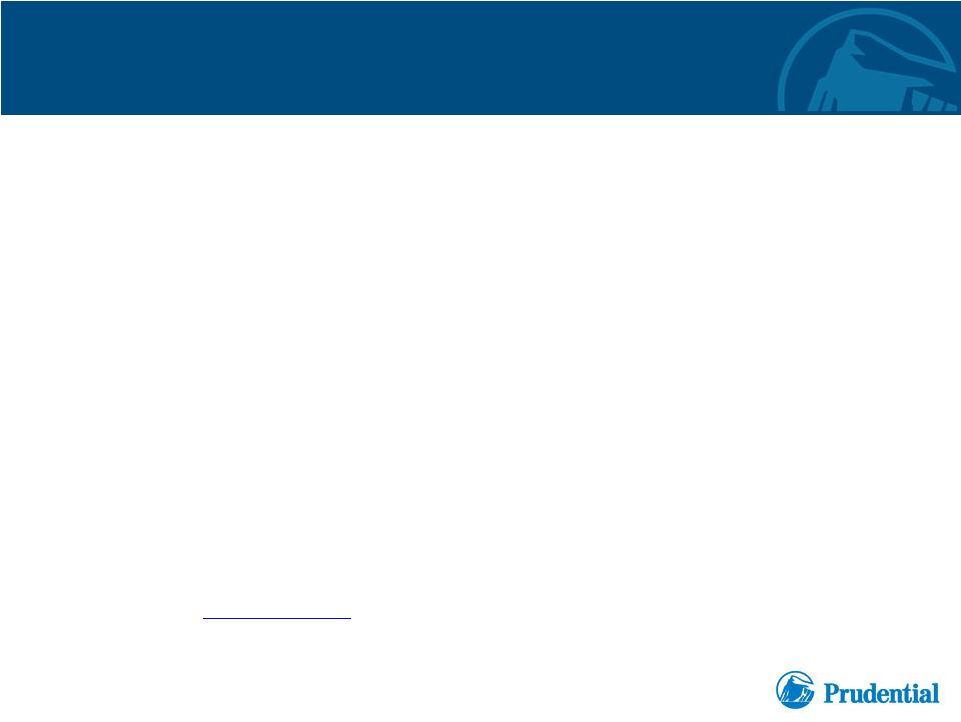 Non–GAAP Measures 3 This presentation includes references to “adjusted operating income.” Adjusted operating income is a non-GAAP measure of performance of our Financial Services Businesses. We amended our definition of adjusted operating income effective for the quarter ended September 30, 2010; the amendment is discussed in our Current Report on Form 8-K filed on November 3, 2010, including a presentation of adjusted operating income in prior periods to conform to the new definition and a reconciliation of adjusted operating income to the comparable GAAP measure. Information presented herein is on the basis of the amended definition. Adjusted operating income excludes “Realized investment gains (losses), net,” as adjusted, and related charges and adjustments. A significant element of realized investment gains and losses are impairments and credit-related and interest rate-related gains and losses. Impairments and losses from sales of credit-impaired securities, the timing of which depends largely on market credit cycles, can vary considerably across periods. The timing of other sales that would result in gains or losses, such as interest rate-related gains or losses, is largely subject to our discretion and influenced by market opportunities as well as our tax and capital profile. Realized investment gains (losses) within certain of our businesses for which such gains (losses) are a principal source of earnings, and those associated with terminating hedges of foreign currency earnings and current period yield adjustments are included in adjusted operating income. Under the revised definition, adjusted operating income excludes realized investment gains and losses from products that contain embedded derivatives, and from associated derivative portfolios that are part of a hedging program related to the risk of those products. Adjusted operating income also excludes gains and losses from changes in value of certain assets and liabilities related to foreign currency exchange movements that have been economically hedged, as well as gains and losses on certain investments that are classified as other trading account assets and debt that is carried at fair value. Adjusted operating income also excludes investment gains and losses on trading account assets supporting insurance liabilities and changes in experience-rated contractholder liabilities due to asset value changes, because these recorded changes in asset and liability values are expected to ultimately accrue to contractholders. Trends in the underlying profitability of our businesses can be more clearly identified without the fluctuating effects of these transactions. In addition, adjusted operating income excludes the results of divested businesses, which are not relevant to our ongoing operations. Discontinued operations, which is presented as a separate component of net income under GAAP, is also excluded from adjusted operating income. We believe that the presentation of adjusted operating income as we measure it for management purposes enhances understanding of the results of operations of the Financial Services Businesses by highlighting the results from ongoing operations and the underlying profitability of our businesses. However, adjusted operating income is not a substitute for income determined in accordance with GAAP, and the adjustments made to derive adjusted operating income are important to an understanding of our overall results of operations. Return on equity (“ROE”) based on adjusted operating income is determined by dividing adjusted operating income after-tax (giving effect to the direct equity adjustment for earnings per share calculation), annualized for interim periods, by average attributed equity for the Financial Services Businesses excluding accumulated other comprehensive income related to unrealized gains and losses on investments and accumulated other comprehensive income related to pension and postretirement benefits. Our guidance for Common Stock earnings per share and ROE are based on after-tax adjusted operating income. Because we do not predict future realized investment gains / losses or recorded changes in asset and liability values that are expected to ultimately accrue to contractholders, we cannot provide a measure of our Common Stock earnings per share or ROE expectations based on income from continuing operations of the Financial Services Businesses, which is the GAAP measure most comparable to adjusted operating income. For additional information about adjusted operating income and the comparable GAAP measure please refer to our Annual Report on Form 10-K for the year ended December 31, 2009, our Quarterly Report on Form 10-Q for the quarter ended June 30, 2010, and our Current Report on Form 8-K filed on November 3, 2010 located on the Investor Relations Web site at www.investor.prudential.com. Additional historical information relating to the Company’s financial performance, including its third quarter 2010 Quarterly Financial Supplement, is also located on the Investor Relations website. The information referred to above and on the prior page, as well as the risks of our businesses described in our Annual Report on Form 10-K for the year ended December 31, 2009 and our Quarterly Report on Form 10-Q for the quarter ended June 30, 2010, should be considered by readers when reviewing forward-looking statements contained in this presentation. |
 November 4, 2010 Prudential Financial, Inc. Prudential Financial, Inc. 4 |
 RICH CARBONE RICH CARBONE EXECUTIVE VICE PRESIDENT AND EXECUTIVE VICE PRESIDENT AND CHIEF FINANCIAL OFFICER CHIEF FINANCIAL OFFICER PRUDENTIAL FINANCIAL, INC. PRUDENTIAL FINANCIAL, INC. FINANCIAL OUTLOOK FINANCIAL OUTLOOK 5 |
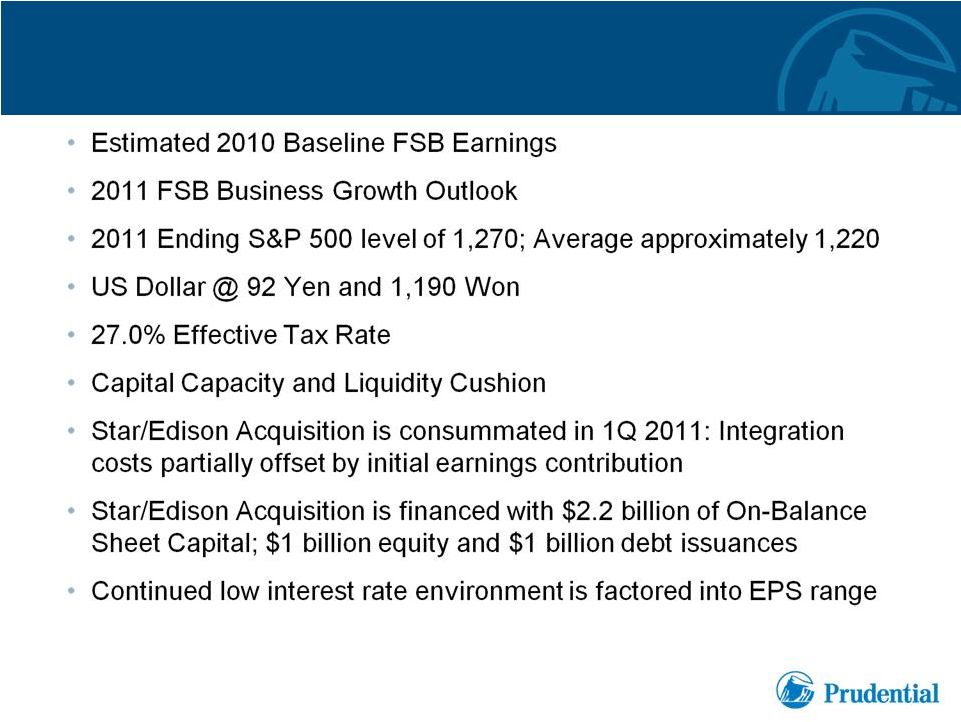 Assumptions for 2011 Outlook (1) 1) Financial Services Businesses. 6 |
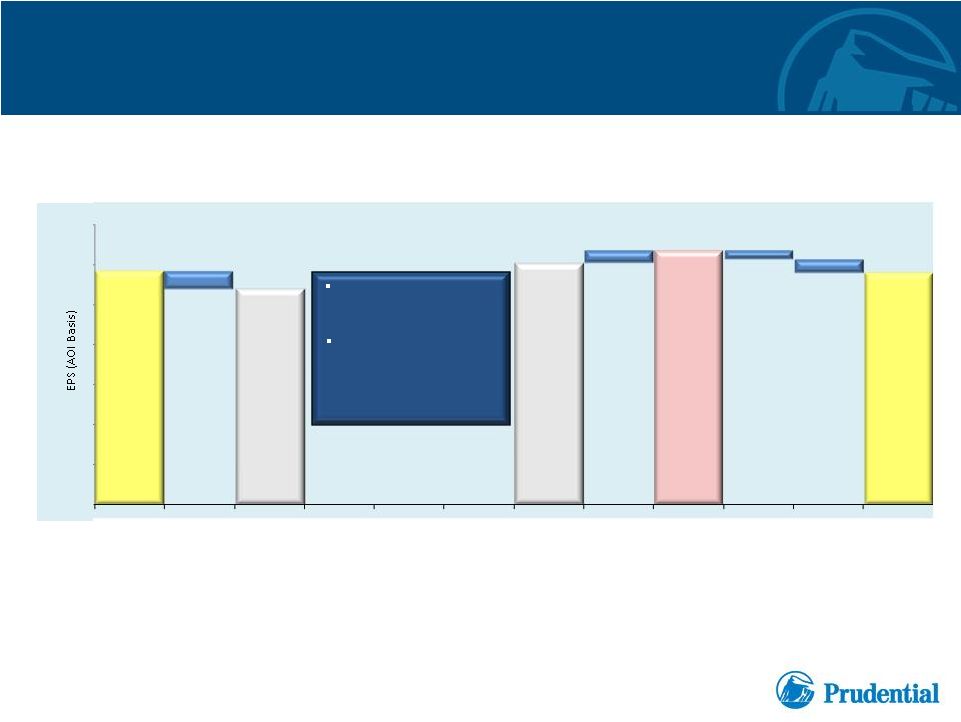 2011 FSB Earnings Guidance (1) 7 2010 Projected 2011 Baseline (excluding Acquisition) $6.15- $6.55 Domestic Business - Business Growth - Market Appreciation - Average Claims Experience -Business growth driven by protection & retirement products -Expanding Distribution -Yen strengthening 2011 (with Star/Edison excluding One-Time Costs) $5.85 - $6.25 2010 Baseline Estimate Unusual / Non-Recurring Items $5.80 - $5.90 $5.35 - $5.45 Full Year Star/Edison, net of Financing Costs (2) 2011 Guidance Star/Edison One-Time Costs (4) $5.60- $6.00 Adjustment for 8 month ownership (3) 1) FSB Earnings per share on an Adjusted Operating Income basis (see page 3 for definition of AOI). All information presented is on the basis of the amended definition of adjusted operating income described in our Current Report on Form 8-K filed on November 3, 2010. 2) Includes annualized 2011 Star/Edison earnings and synergies, net of financing costs and impact of dilution from the share issuance. 3) Reduction to 2011 earnings to reflect estimated 8 months of ownership of Star/Edison. 4) One-Time Costs include both Integration and transaction costs related to the acquisition of Star/Edison. International Businesses |
 2010 Capital and Liquidity Projection – Financial Services Businesses (“FSB”) 8 1) Required Capital represents the amount of GAAP capital necessary to support business risk at an A rating at Prudential Financial Inc. (“PFI”) and AA rating at the operating entities. Required Capital pro forma for Star/Edison assumes repayment of the assumed debt associated with the Star/Edison acquisition using excess capital within the acquired entities. 2) Excludes accumulated other comprehensive income related to unrealized gains and losses on investments and pension and postretirement benefits. 3) Based on assumed Risk Based Capital (“RBC”) of 400% for Prudential Insurance. 4) For the purposes of calculating this ratio hybrids are considered 25% debt and 75% equity at December 31, 2009 and 25% equity and 75% debt at December 31, 2010. 5) The inclusion of RBC measures is intended solely for the information of investors and is not intended for the purpose of ranking any insurance company or for use in connection with any marketing, advertising or promotional activities. 6) 2009 actual ratio is as of 3/31/10. 7) Net cash includes cash, cash equivalents, and short-term investments, reduced by commercial paper borrowings and an intra-company liquidity account at PFI, the parent holding company. |
 Considerations for Long Term ROE (1) • Superior Business Mix • Business Growth • 8% S&P Growth • Current Forward Curve for Interest Rates • US Dollar @ 82 Yen and 1,190 Won • Capital Deployment • Capital Capacity and Liquidity Cushion • Leverage • Regulatory Reform 1) Financial Services Businesses. 9 |
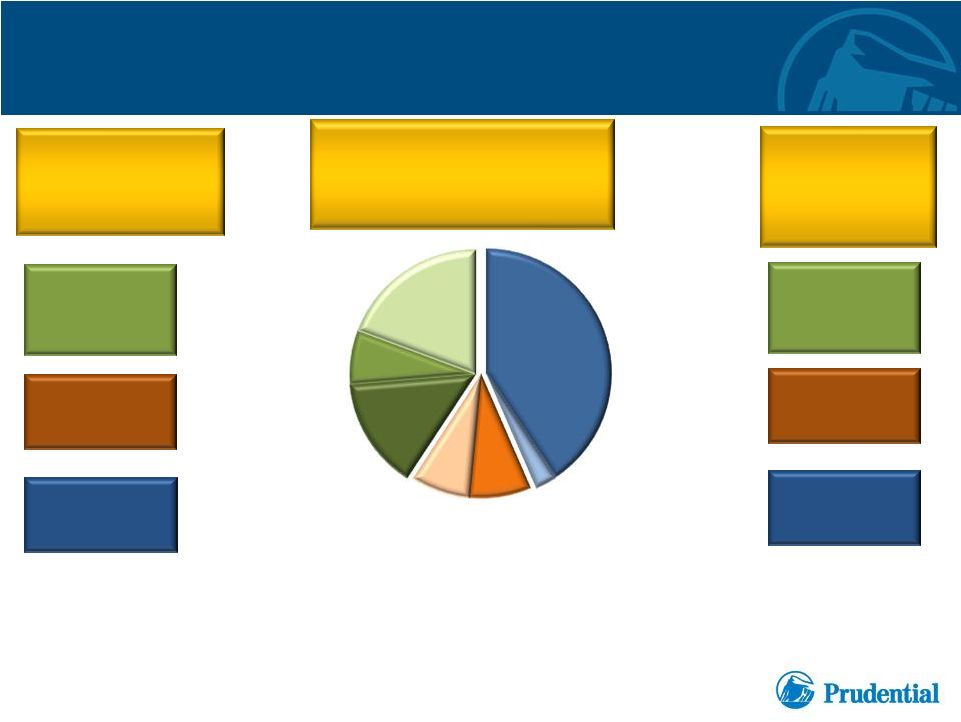 Superior Mix of High Quality Businesses- Enhanced by Star/Edison Acquisition (1) 1) Business unit ROE’s are unlevered and are based on FSB effective tax rate applicable to Adjusted Operating Income. 2) Projected attributed equity of Financial Services Businesses as of December 31, 2010, excluding accumulated other comprehensive income related to unrealized gains and losses on investments and pension/ postretirement benefits, adjusted to give pro-forma effect to Star/Edison acquisition and expected financing thereof; excludes Corporate and Other. 3) Includes Corporate & Other results, including costs of Capital Debt. 4) Includes Star Edison. 2010 PROJECTED ATTRIBUTED 2010 PROJECTED ATTRIBUTED EQUITY EQUITY PRO FORMA FOR STAR/EDISON PRO FORMA FOR STAR/EDISON $28.7 BILLION $28.7 BILLION (2) (2) Individual Life & Group Ins 2010 Baseline ROE 10% - 11% Annuities, Retirement & Asset Mgmt 2010 Baseline ROE 11% - 12% International Insurance 2010 Baseline ROE 19% - 20% FINANCIAL SERVICES FINANCIAL SERVICES BUSINESSES BUSINESSES 2010 BASELINE ROE 2010 BASELINE ROE ~10% ~10% (3) (3) FINANCIAL FINANCIAL SERVICES SERVICES BUSINESSES BUSINESSES 2013 ROE POTENTIAL 2013 ROE POTENTIAL 10 Individual Life & Group Ins 2013 ROE Potential 12% - 13% Annuities, Retirement & Asset Mgmt 2013 ROE Potential 14% - 15% International Insurance 2013 ROE Potential 17% - 18% (4) (4) Annuities 19% Asset Management 7% International Insurance 41% Group Insurance 8% Individual Life 8% Retirement 14% International Investments 3% 13% - 14% (3) |
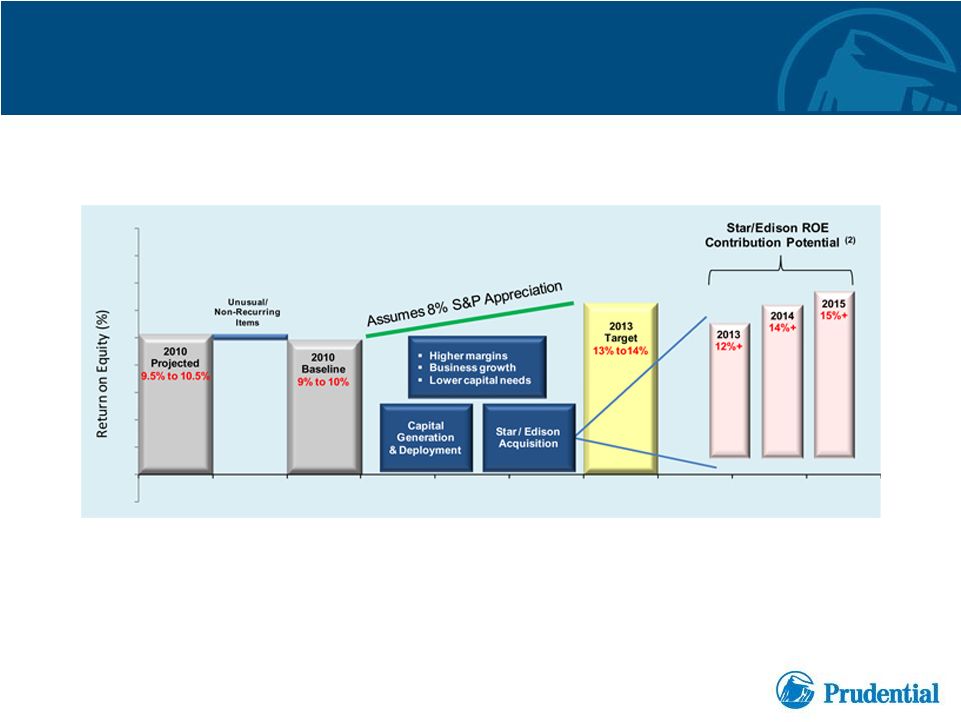 11 Business Plan for ROE Growth: 2010 – 2013 (1) 1) Financial Services Businesses. 2) Star/Edison Deal ROE is calculated assuming 25% leverage and includes one-time costs in Required Equity. |
 November 4, 2010 Prudential Financial, Inc. Prudential Financial, Inc. Questions and Answers Questions and Answers 12 |